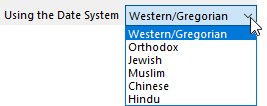
There are 12 identical sets of options, relating to the tokens [MonthHeader1] to [MonthHeader12] respectively.
MonthHeader tokens are used to automate the different ways you may wish to display the month and year (usually, but not always, at the top of a diary page), depending if a change of month or year occurs on the current page or 2 page spread, such as in the example below.

For each of the available [MonthHeader] tokens, you must specify the conditions that determine what type of change, if any, is occurring.


If you use either 0 or -1 as DayValue setting, then you must make sure that the date of the MonthHeader token is within the month whose beginning and end you want to use to test for a change of month (presumably in another date system). Since these settings will usually be used in the context of a monthly grid, you should then use a DayValues that is guaranteed to be within the month such as 8, 50, 92, ... values corresponding to 7 days after the first DayValue of a month.

Using Date System
Use this setting to determine if Q++Studio is to look for month/year changes in the Gregorian calendar (the Western calendar used by most businesses worldwide), or any of the other calendars supported by Q++Studio, such as Orthodox, Chinese, Muslim, Jewish or Hindu.
Text/Tokens to use depending on the type of change
The No Change, Month Change and Year Change settings are text fields where you can enter the tokens and text to use in place of the [MonthHeader] token(s), depending on what happens between the 2 dates corresponding to the 2 DayValues selected above.
•If you do not use a LanguageTag in the tokens here, then the tokens here will be assumed to use the LanguageTag of the originating MonthHeader token.
•If you do specify a LanguageTag in the tokens here, then this LanguageTag will override the LanguageTag of the originating MonthHeader token.
•You can use macro tokens.
•You can mix special character markers with the tokens here.
•You can copy MonthHeader Options from one of the 12 indices to another.
See also: MonthHeader Tokens, special character markers, the structure of tokens.
Topic 172420, last updated on 10-Nov-2023
